Bridging federal frameworks for data sharing
When states look to broaden the types of information included in a longitudinal data system, aligning legal agreements across sectors and departments, such as education, health, and financial aid, can be a common stumbling block. There are well-established federal guidelines for data sharing in each context, but they do not precisely align for this kind of work. When lawyers get together to develop the data sharing agreements necessary to create linked data sets, they may struggle to bridge these federal legal frameworks in ways that ensure no agency is out of compliance.
Include all key players in crafting agreements

In California, which committed to bridging education, health, and financial aid legal frameworks in the first months of planning (see the Purpose and Vision section), a team of lawyers from 16 state agencies identified a way to do so. The planning team ensured that all key players helped to craft the proposal, including attorneys that represented both the data providers and the entity hosting the data. While smaller groups of lawyers developed preliminary language, all lawyers approved the wording before advancing the agreements for signature. Broad participation from the earliest stages of developing the legal agreements also meant that the legal counsel were willing to accept near-final wording that might benefit from minor modification, rather than striving for perfection.
Understand federal and state statutory requirements
The California planning team included a lawyer with a strong background in crafting data-sharing agreements among education institutions, who was advised closely by one attorney who had helped to broker a data-sharing agreement among health and social service agencies and another familiar with federal financial aid laws. They identified content that needed to be included in legal agreements, based on more limited data-sharing that had been implemented in other contexts. This helped to create the outline for the Cradle-to-Career system legal documents. The planning team also developed crosswalks to ensure that required statutory language was consistently referenced in the various agreements.
One persistent challenge in the planning process was misperceptions about the federal frameworks for education data — the Family Educational Rights and Privacy Act (FERPA) — and health data — the Health Insurance Portability and Accountability Act (HIPAA). Some core concepts in these frameworks, such as exemptions, the delegation of authority, and appointments of authorized representatives, were often interpreted in ways that would not allow for data sharing, when in practice other states or partners had interpreted those same clauses to allow access to information. Also, there were information gaps relating to the myriad state laws, regulations, and practices that applied to each data contributor’s specialized fields. Therefore, the planning team prepped for and spoke with great specificity about each framework and brought in an expert associated with the U.S. Department of Education to clarify federal requirements for both data provider representatives and the general public.
Including references to FERPA and HIPAA
You can use this information to better understand how common concepts are represented in each framework.
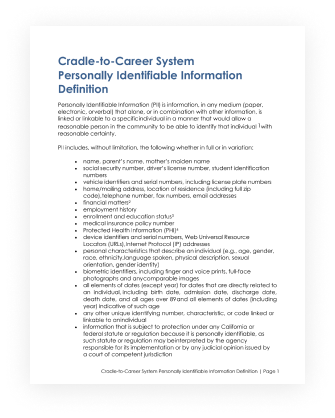
Don’t try to create one single agreement
There are different allowable uses of linked data, depending on who is accessing it and for what purpose. One way to bridge multiple federal frameworks is to be highly specific about concepts like delegated authority for handling sensitive information. For example, different criteria should be applied to the entity hosting the data system, which will need to work with highly sensitive records like social security numbers to identify the same person across multiple data sets, compared to a researcher who will be accessing anonymized data.
To ensure the appropriate uses and authorities are applied, the California data system will use four distinct types of agreements based on the specific parties involved and data uses. These agreements include:
- Participation Agreement: This agreement is between the data providers and the entity hosting the data system, to establish the specific contexts in which the host may access and use the data.
- Research Agreements: These agreements are between the data provider, the data requestor, and the entity hosting the data system to allow for access to specific data points for approved projects where individual-level, anonymized information is needed, such as for a program evaluation. Each agency will have its own standard research agreement associated with the Cradle-to-Career system, which means that requestors must sign multiple agreements if they are accessing data provided by more than one agency.
- Partner Agreements: These agreements are between the entity hosting the data system and the existing state projects that provide student-facing tools that will be scaled as part of the Cradle-to-Career system (see the Technical System Design section). These tools require a different legal framework because they provide access to information for individual students by name. For example, information may be provided to an authorized high school guidance counselor about whether a specific student has successfully submitted a college or financial aid application or may need help to complete that task.
- Data Exchange Agreements: This agreement is between the data providers, in cases where they seek to use data for purposes not specific to implementing the Cradle-to-Career system, such as for a joint research project. The agreement includes a master agreement that sets general terms and conditions for data sharing that only needs to be signed once, and a business use case proposal that will be filled in for each approved project, such as documenting the data elements and duration of time they may be shared.
Summary of content in legal agreements
You can use these lists to determine whether there are topics that could be added to your state’s legal agreements.
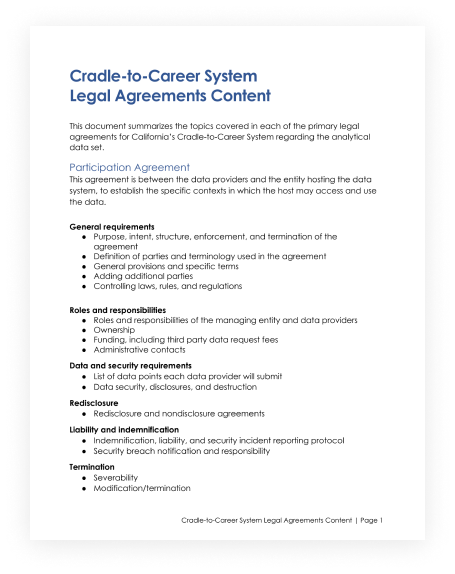
Ensure consistency
Because there are multiple agreements governing access to information in the California Cradle-to-Career system, another important task was to ensure consistency in the use of terminology and procedures across legal documents. For example, during the planning process, the legal counsels developed a definition for personally identifiable information that encompassed the differing requirements under state laws, FERPA, and HIPAA. This consistent definition then needed to be referenced in each of the data system legal agreements.
Consistent references to FERPA
View a list of FERPA exemptions that can allow data sharing
You can reference this list to ensure that exemptions are referenced appropriately across documents.
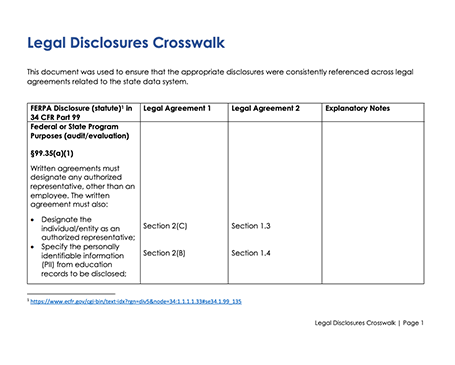
Change statute where needed and allow for flexibility

Attorneys from the data providers identified a number of ways that state law needed to be changed, informed by their own earlier data sharing attempts. However, the planning team made sure to not make the legislative changes so prescriptive that they would hamper future development of the system.
For example, a law was passed that defined the scope of the data system and mandated that state agencies enter into an agreement to implement the Cradle-to-Career system. However, the specific data points that would be submitted were not outlined in statute; instead the law refers to the data sharing agreement between the data providers and the host entity. This was done so that the data scope in the agreement could be amended over time to include new data points or to sunset data points that are no longer collected without needing to change the law. See the Sustainability section for more details about changes in statute.
Align the data structure and access with legal requirements
In reviewing federal laws, the attorneys from the data providers were clear that responsibility for granting access to individual-level data could not be delegated to a third party. This led to the recommendation that access to individual-level, anonymized data for research purposes must be approved by each provider included in the data request. However, some members of the research community expressed concern that state agencies would be reluctant to share information when these requests are made. Therefore participants in the planning process identified three ways to make it more feasible to share information within federal legal frameworks.
- Make as much information available to the public at the aggregate level as possible: The data providers agreed that 200 data points would be made available to the public through a query builder tool that allows users to drag and drop the data points of their choice to create summary tables. Users would not need to ask permission to access this level of data. To safeguard the information of individuals, the planning team convened experts to craft a suppression protocol that meets health data standards and surpasses education standards. A suppression protocol is a set of rules for processing data that ensure information is displayed for large enough groups that it would be difficult to determine the identity of specific individuals. Learn more about the data points in the Selecting the Data section.
Keeping individual identities concealed
See a suppression protocol that addresses requirements under both FERPA and HIPAA.
You can evaluate whether this approach for grouping records would help to alleviate concerns about individual identities being revealed.
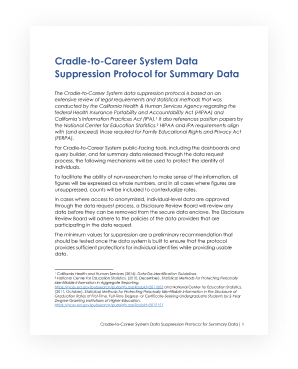
- Support data requestors seeking permission to access individual-level, anonymized data: With input from researchers, data providers crafted a process designed to approve credible requests for access to data. This includes aligning the application with the state’s institutional review board process, providing transparency about requirements to access data, and having the entity hosting the data system help requestors clarify their proposal and research questions if needed before forwarding requests to the data providers.
Supporting agencies to allow for data sharing
See the California Cradle-to-Career system data request process.
You can evaluate whether this approach would help to address concerns about legal data access and workload for your state.
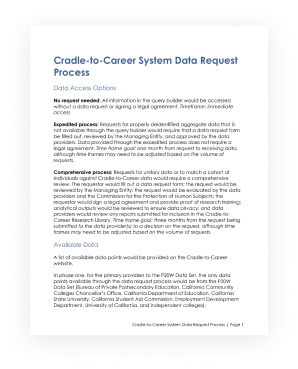
- Provide information about data requests, status, and rationale for denials: All requests for access to individual-level, anonymized data will be visible on a public website, so that anyone can see what requests have been made and the status of that request. In addition, an advisory board will review all rejected requests each year to determine ways to improve the process to ensure that credible requests are granted.
